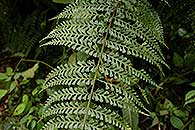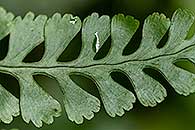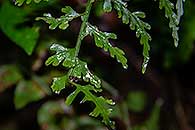Asplenium rukararense Brause
Synonyms |
|
|---|---|
Common name |
|
Description |
Rhizome shortly creeping (type erect), to 3 mm diameter; rhizome scales mid-brown, elongate-deltoid in outline, apex pointed ending in hair-tip, to 8 x 2.5 mm, becoming glabrous. Fronds to 40 cm long, proliferous just below the apex. Stipe grey, 10-20 cm long, sparsely set with linear scales. Lamina lanceolate in outline, 25-35 x 8-17 cm, 2-pinnatifid, basal few pinnae slightly reduce, dapex decrescent. Pinnae 15-20 pairs, to 9 x 2.4 cm, deeply pinnatifid, linear-lanceolate in outline, base subtruncate; ultimate segments in 11-13 pairs, basal ones bifurcate or trifid, others with a notch at the apex, lobes ovate with toothed apex and decurrent base. Sori at the base of ultimate segments, 1.5-3 mm long; indusium membranous, entire, to 0.4 mm wide. |
Notes | Albetine Rift Endemic. |
Derivation | rukararense: of the Rukarara; this species was first discovered in the source area of the Rukarara river in Nyungwe forest, Rwanda. |
Habitat | Montane forest, 1900-2600m |
Distribution worldwide | See African distribution. |
Distribution in Africa |
|
Growth form |
Terrestrial. |
Literature |
|





